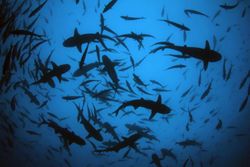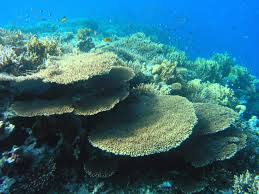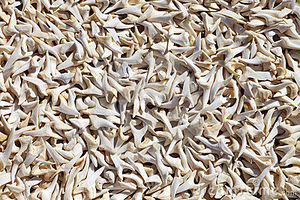
|
The Jedi were real? This article is part of the history of Clan Odan-Urr and isn't part of current events.
Please do not remove this tag or the contents. These articles exist for historic purposes.
|

|
| Tetocoyan Reef Shark
|
|
Shark
|
|
Non-Sentient
|
|
New Tython
|
|
10 years
|
|
1 foot
|
|
Dark gray
|
|
Black
|
|
Thin, streamlined shape
|
The Tetocoyan, known by Tythonians colloquially as the Reef Shark, is a large predatory fish found in the Bythic Ocean of New Tython. Typically found in coral reefs but also located near coastlines and cave systems, these sharks are long and streamlined, and are distinctive in that they swim in small schools. Known for swimming between coral and stone outcroppings, they are predators that rely on speed, numbers, and the element of surprise - making them a scourge for Harakoan and Tythonian fishermen alike.
Biology
The Tetocoyan is a salt-water shark found primarily close to coastlines or within rocky outcroppings and cave systems. Small, only about one foot in length, their bodies are long and thin, with an elongated and nearly straight tail fin. Its pectoral fins, long and dexterous, are quite strong and durable; made of thick cartilage, the shark will extend one fin or the other to generate sudden drag in the water and execute sharp turns while at speed. In the place of one large dorsal fin, the Tetocoyan actually has three, each of which is only about an inch high and extends down the length of the fish's body. These are thought by biologists to "slice" the water around the fish as it hurries along, reducing drag and allowing it to move at speeds of up to 60 miles per hour.
The small eyes of the Tetocoyan are wide and black, ideal for searching through dark waters, though these are typically only used to locate predators and prey; in fact, rushing Tetocoyans will snap a whitish membrane over their eyes while at top speed to protect them, giving the false impression that their eyes are milky white to many observers. They possess four sets of gills, two on the sides and two under the belly; they have small ridges protruding, almost like hip bones, around these gills to allow them to breathe while at full attack speed. The most remarkable feature, though, is the animal's mouth. Rows of teeth line the maw, which makes up one third of the animal's body and opens wide, like a cylinder, allowing them to crash into or swallow prey whole while in pursuit.
Tetocoyan teeth are short and sharp; the outer rows grow in a straight, cutting point while the top and bottom of their mouths are lined with lower, barb-like teeth that run down their throat. The fish will use these to hang onto meat stolen in a rapid bite, and to drag their prey back into their throats while on the move. Their strong jawbones are shaped to wobble while they swim, allowing them to work food in without too much effort. The bones are strong enough to allow high-speed turns while eating, making them all the more lethal to cornered prey.
An impressive, yet understated, feature of the Tetocoyan is the developed nervous system of its skin; using this, they are able to swim at full speed and execute hairpin turns and sudden stops or dives while completely blind. They do this by detecting changes in scent, electricity, water pressure, and temperature around them; though their thinking skills are simple, Tetocoyans have a reaction time of one one-hundredth of a second.
Behaviour
Tetocoyan Reef Sharks are social creatures, and swim in schools of anywhere between three and fifteen sharks; the size of such a school depends on available food, and schools have been known to split apart when food grows scarce or even to eat one another in times of desperation. Though they usually drift and weave through coral reefs at a slow, casual pace, they will do what is known by the Harakoans as a "death weave" when hunting. Tetocoyan schools will swim a small distance from the prey, before assembling into a long line and rocketing toward their prey. What will follow is a dramatic, high-speed chase during which the slender sharks race, pivot, and dart around obstacles to capture their prey. Most interestingly, no two sharks will go the same way; instead, while pursuing a prey animal, they will weave around it to drive it toward the rest of the swarm and toward tighter confines. The prey animals are typically schools of fish or squid, though at times the sharks will gang up on larger animals.
 Coral reefs such as this one in the Bythic Ocean often play host to ambushes by Tetocoyan sharks.
Coral reefs such as this one in the Bythic Ocean often play host to ambushes by Tetocoyan sharks.
Once the chase has ended, the sharks will look to cripple larger prey, targeting gills, fins, and even the eyes to prevent an escape. They will tear it apart, forming a writhing cloud of twisting sharks as they tear pieces off of every exposed surface in a feeding frenzy; once the feeding is done, the sharks will scatter, often leaving nothing but a cloud of blood and viscera in the water. After they have scattered, they will regroup within reefs or caves, using tight tunnels and spaces to avoid the inevitable approach of larger creatures to the kill sight. Known as a Harakoan-eating shark, these creatures will often swarm unwary or solitary tribals and colonists, though many divers carry precautions such as sonic or ionic weapons to fend them away. Not one to engage large groups of superior predators, the sharks will typically leave organized and protected divers alone entirely, opting instead for an easier meal.
One place where one can rarely see more than one school of Tetocoyan is at the site of shipwrecks or other places with large numbers of floating, dead bodies. Tetocoyan are opportunists, and will often attack wounded creatures or scavenge in place of hunting, swarming dead bodies and eating nearly everything they can bite through, down to the bone. They have been called the Bythic Ocean's gravekeepers by coastal and seafaring tribesmen, namely because they are known for devouring the vast majority of floating carcasses within the waters; shipwrecks can draw as many as five schools, while something as huge as a whale carcass is not unknown to draw hundreds over the course of weeks.
Their opportunism has led to Tetocoyan going after the catches of fishermen, often ravaging larger snagged fish and getting caught in nets in their mad rushes for food. Because of this, coastal Harakoans often net the shallows around their villages, both to capture the speedy fish and to prevent their children from being attacked. This is a constant concern for Harakoans, for while a strong-swimming adult with a spear is often left alone, small children are often slower and more appealling to the sharks.
Mating Behaviours
Tetocoyan do not breed in the typical manner; instead, females are impregnated by males and rapidly swell over the course of the week, developing what is known as a "birthing sack." Females will swim to caves and dark, hidden nooks and will give birth to these sacks, which will swell with squirming offspring for another two months before tearing forth to produce over a hundred small, six-inch offspring. These will then seek the tightest confines they can, swimming in larger schools after crustaceans, small fish, cephalopods, and mollusks for sustenance. As they grow, the schools will often fight, until they reach maturity at three months of age and split into smaller schools. These are often preyed upon by stealthy or large predators; in total, maybe twenty individuals of a given birthing sack will survive to maturity, of which ten may carry on. While brutal, this has led to an evolutionary perfect opportunist.
Tribal and Economic Uses
Being sleek and slender, Tetocoyan typically are not fished for their meat; while edible, they will scarcely be a good meal. However, they are often sought after for their tough pectoral fins and their many sharp teeth. Typically, their outer teeth are used for arrowheads, knives, and spear tips, while the curving lower teeth are used for stitching needles and to line the edges of clubs and polearms. In addition, their strong jawbones are often used in the creation of digging tools and clubs, their natural strength lending themselves well to both tasks.
 Tetocoyan teeth are often used as weapons and as tools.
Tetocoyan teeth are often used as weapons and as tools.
Nutrient-wise, the only really beneficial parts of the body are the liver and the eyes. The oil of the liver is kept and traded between tribes supposedly as a curative fluid for many ailments, though this has not been verified by colonial or Jedi scientists, though it also contains many nutritional benefits. The eyes themselves are nutritional hotspots, packed with vitamins and minerals; in addition to being a delicacy, they are often sought out by survivalists to stave off starvation. They can be salted and preserved, though over time their nutritional value will wane and eventually disappear.
Some Harakoan religious beliefs on the coast often put great faith in the speed of the sharks, as well as putting emphasis on them as messengers of life and death. As they clean the ocean of bodies, the tribals often believe that they carry the souls of the dead away. Because of this, and of their speed, lethality, and precision in the water, some warriors will fashion garments of their skin and bones to wear in combat; according to the legends of some, this is said to bestow the speed, agility, and lethal touch of death itself upon said warrior's weapons. Many tribes clad their best warriors in such garb, and though it is not known to bestow actual skill or benefits in and of itself, some Jedi philosophers have noted that the confidence of the wearer - and fear of his opponent - often lend themselves to the wearer's success on the battlefield.